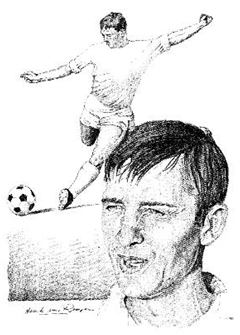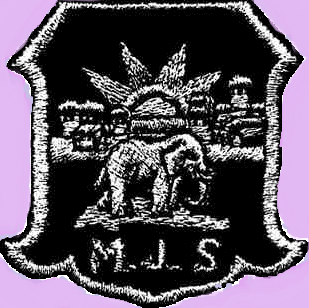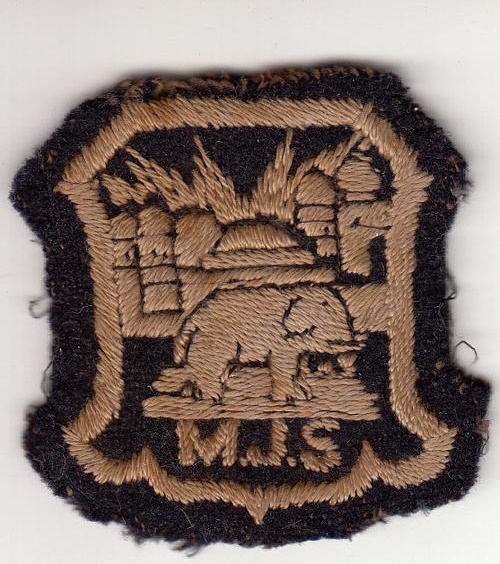Robert Barry Lionel Chalmers
Robert
Barry Lionel Chalmers
was born at Bulawayo on 19 February 1941 and attended Raylton Junior and
Milton High Schools. At
Milton he showed promise as
a rugby player and was 1st XV full back, and once appeared as the
Rhodesia cricket team's twelfth man in a first-class inter-provincial
match but he had been bred on soccer, playing in the junior ranks for
Queens, where he came under the influence of Bobby Styles., However, he
proved a more keen soccer player, and honed his skills as an amateur in
the youth teams at Queens Sports Club, usually playing as a winger.

Although his eldest brother, Des, represented Rhodesia at both rugby and
cricket, it was the soccer path which was to lead Bobby to glory and in
1961 he played for Rhodesia against Leicester City (lost 4-3) and West
Ham (lost 3-0 and 5-0).
In 1962 Chalmers married Salisbury girl, Audrey Linden, and later that
year they headed south in a beat-up Volkswagen. He was given a soccer
trial by Durban City and was quickly signed on by the astute Norman
Elliott — at R40 a month plus bonuses. So was launched the brilliant
career of a real 'Bobby Dazzler'. He went on to win numerous awards and
accolades while scoring hundreds of memorable goals and taking over the
mantle of the famed Les Salton as the most marked man in South African
soccer.
Santa Maria couldn't believe his eyes. The imposing
Real Madrid centre-half, one of the world's most famous soccer
defenders, stood hands on hips and mouth agape as the ball rattled into
the Madrid net and the 35 000 crowd at Johannesburg's Rand Stadium
erupted with delight. Zimbabwe-born Bobby Chalmers had had the audacity
to beat Santa Maria hands down and score one of the most brilliant
opportunist goals seen in South Africa. The chunky blond Chalmers, just
5 ft 7 in. (170 cm) of soccer dynamite, was playing in a roving
attacking role for the South African Knights that glorious evening of 8
September 1964. John Rugg, former Queen of the South player in Scotland,
and later Zimbabwe's acting national coach, who was then playing for
Durban City, was South Africa's captain.
Although Real Madrid won 5-2 it was Chalmers who scored both home team
goals to record one of his proudest games. It was also in 1964 that
Chalmers thrilled his fans with a hat-trick for Durban City against
Jewish Guild in the Castle Cup Final, all his goals coming in the second
half. This was the only hat-trick scored in a final and his greatest
year was climaxed by being named Footballer of the Year.
Although his record-breaking soccer career was forged in South Africa,
Chalmers did return to his homeland to captain the then Rhodesia into
their first World Cup challenge in 1969. His fluent knowledge of both
Shona and Ndebele, coupled with his vast experience and legendary
stature in South Africa, made him a popular leader who brought out the
best qualities in his men.
Rhodesian soccer truly came of age with this entry for the 1970 World
Cup. Few gave them even a remote chance of winning their qualifying
section, let alone reaching the final sixteen in Mexico, but two years
of intensive coaching by Scotsman Danny McLennan produced a proud and
motivated team that twice held the might of Australia to draws before
losing the third game 3-1.
The full eighteen-man squad was: Robin Jordan, William Sibanda, Peter
Haddon, James Chibaya, Isaac Chieza, Shepherd Murape, Topsy Robertson,
George Shaya, Hylton Grainger, Nelson Mapara, Alex Mwanza, Gibson
Homela, Itayi Chieza, Philemon Tigere, Adolf Mutuma, Stewart Gilbert
Stewart Knowles and Bobby Chalmers.
For the 1969 qualifying rounds, Rhodesia were placed in Group 15 — the
Asian-Oceanic Group. Despite being in the heart of Africa, Rhodesia were
not included in a section from this continent, the FIFA Organising
Committee noting that none of the African countries which had entered,
maintained diplomatic relations with Rhodesia. Indeed, at this time only
a few countries in the world recognised Rhodesia following the
Unilateral Declaration of Independence.
But political rumblings also threatened to split Group 15 after it had
been decided to form two sub-groups by lots, and Rhodesia found herself
with Japan, the Korean Republic and Australia. The venue for this Group
15/1 was fixed as South Korea, but a month before kick-off the
Government of the Republic of Korea warned that it would not issue visas
to the Rhodesians.
After a hurriedly arranged compromise, the tournament did take place in
Korea with only Korea, Japan and Australia participating and the winner
was instructed to play Rhodesia on a home and away basis. The
Australians emerged victorious with two wins and two draws and had to
play two matches against Rhodesia to decide the qualifier for Mexico.
The vast distance between the two countries and the shortage of time
made the home and away ruling impossible and eventually Lourenco Marques
in Mozambique was chosen as the venue.
The historic date for the first match was 23 November 1969 when the
teams drew 1-1 after no score at half-time. The second clash ended in a
no-score draw and it was necessary to go to a play-off, which the
Aussies eventually won 3-1. Only 7 000 people saw the three games — a
great pity, for had they been played in Salisbury 100 000 or more would
almost certainly have been attracted. But it was a thrilling series and
the Rhodesian team was hailed on its return and the nation's football
received a notable boost.
It was Alf Boyd, the Durban City manager, who, in 1964, decided to move
Chalmers permanently from wing to centre-forward. The move paid handsome
dividends — he scored 58 goals that season, just two short of Salton's
record. However, it was in June 1963 that Chalmers played in the middle
for the first time as an experiment in a first-round Castle Cup match
against Kimberley United. Bobby netted seven goals in an overwhelming
14-1 victory and the next week scored a hat-trick before his delighted
home spectators against West Rand United. Nevertheless when the 1964
season opened he was on the flank again for the first seven matches
before switching back permanently to the middle. This marked the
turning-point of his career.
During the off season he had worked tirelessly to iron out the flaws in
his game and he was no longer just a chaser of balls down the middle. He
became a polished all-round player, whose subtle touches kept his
strikers moving fluently. He had developed a powerful shot with either
foot and his headwork had improved out of all recognition. He had lost
none of his dash or zest and in 1964 became by far the most valuable
piece of footballing merchandise in South Africa, while losing none of
his natural charm and modesty.
Chalmers played for Natal against Arsenal, the famous English club, in a
disastrous 8-2 defeat but later in that 1964 season when Real Madrid
toured, his moment of destiny had arrived as the South African Castle
Knights earned the greatest honour in a 5-2 defeat at the hands of the
magical Spaniards. It was a wonderful soccer spectacle and for Bobby a
night of glory. Real cantered to a 3-0 half-time lead, then in the
second half, Chalmers set the terraces alight with a rasping shot after
beating two defenders. Then, with Real leading 5-1, he hit another great
shot for his second goal.
Amongst his most prized goals was one scored before his home supporters
against Durban United in the Castle Cup quarter-finals at Durban's new
Kingsmead. United, with goals by Ronnie Mann and Les Salton, had run
into a 2-0 lead within thirteen minutes, with City poaching one back a
minute from the interval. It was a cracking pace in the second half,
when Chalmers picked up a pass and raced along the edge of the penalty
area with three defenders in hot pursuit. suddenly he stopped, almost
dead in his tracks, and as his pursuers skidded to a halt he slashed a
shot into the net.
Also in 1964 he stunned spectators and the Arcadia Shepherds by scoring
three goals in four minutes for Durban City ... and Shepherds had
Springbok goalkeeper Trevor Gething! Little wonder Bobby Chalmers was
Footballer of the Year.
City dropped a bombshell when they transferred Chalmers to Durban United
in 1966 for a South African record of R20 000. From there, he moved on
to Maritzburg in 1968. With Chalmers spearheading their attack,
Maritzburg's fortunes immediately soared and they won the national cup,
took part in the champion of champions tourney and were beaten finalists
in the bowl.
In 1969 he grabbed the winning goal for Maritzburg in the Castle Cup
Final against Cape Town City at the Rand Stadium, unleashing a typical
thunderbolt in extra time after the teams had been deadlocked at 1-1. It
was in this year that Chalmers responded to a call from his home
country, Rhodesia, to lead them into World Cup qualifying combat. In a
warm-up match against Malawi at Salisbury's Gwanzura Stadium, Rhodesia
won 4-0 and Chalmers — who scored a goal — was man of the match.
It was early in 1974 — when he was plagued by knee trouble and at the
end of his brilliant career — that Chalmers finally broke Salton's
long-standing South African National League record of 294 goals. He went
on to score over 300, though a succession of leg injuries eventually
sidelined him for good. He now lives in Durban where he is a public
relations officer for a group of hotels.
To demonstrate the power of his shot, Chalmers was once put to the test
in Maritzburg, when a bare-foot shot was timed at 78,4 mph with an
accurate electronic device. This was claimed as a world record.
England's Peter Lorimer had won a similar competition in England, timed
below 80 mph with his boots on. A graceful stylist, with a supple swerve
and cannon-ball shot, Chalmers was always the perfect gentleman and
sportsman. He deserved the accolade as Southern Africa's Crown Prince of
Soccer.
 Milton Junior School
Milton Junior School